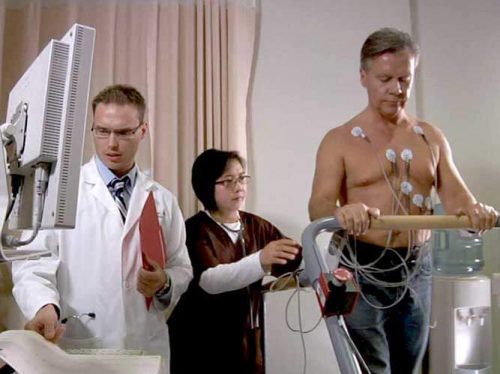What is a Stress Test?
A stress test (exercise stress test or treadmill stress test) involves walking on a treadmill with increasing levels of difficulty, while your electrocardiogram, heart rate, and blood pressure are monitored.
A stress test is used to provide information about how your heart responds to exertion.
- Time: approximately 60 - 75 minutes

Why is it done?
Your doctor might request a stress test to:
- Check for heart rhythms problems (arrhythmias)
- Diagnosis or monitor coronary artery disease
- Evaluate the blood flow to your heart during increasing levels of activity
- Determine the effectiveness of your heart medications
- Monitor the success of procedures done to improve blood flow
- Determine how much exercise you can safely tolerate during rehabilitation
How do I prepare?
There are a few things you should and shouldn’t do prior to your stress test appointment:
Before your test
For 24 hours prior to your test:- Stop any beta or calcium blockers. DO NOT STOP if you have had a heart attack, cardiac stent, cardiac bypass or coronary artery disease.
On the day of your test
For 4 hours prior to your test:- Do not consume caffeine including: tea, coffee, decaffeinated products, chocolate, soda pop or medications containing caffeine
- Eat a light breakfast of lunch only. Do not eat a large meal
- Do not drink alcohol
- Do not smoke
- Bring all of your medications with you in the original bottles.
- Do not wear a nitro patch
- If you are a diabetic on insulin: Take 1/2 of your normal insulin dose (the exercise will lower your blood sugar)
- Do not apply any lotions, creams or powders to the chest area.
- Wear a comfortable two-piece outfit and athletic shoes.
What happens during the test?
A stress test is performed by a certified technician.
- You’ll be asked to remove clothing from the waist up and be given a gown to wear.
- Several small electrode stickers (sensors) will be attached to your chest. These will be connected to a machine that monitors your heart beat during the test (ECG).
- A cuff will be placed on your arm to monitor your blood pressure during the test.
- You’ll then exercise on a treadmill, starting slowly and gradually increasing intensity.
- You’ll continue to exercise until you reach your target heart rate (varies depending on your age & fitness level) – Approx 10 to 15 minutes or until you have signs and symptoms that don’t allow you to continue.
- After you stop exercising, you may be asked to stand still for several seconds then lie down on the exam table with the monitors in place.
Your doctor will watch your heart activity closely and stop the test if there are any concerns
Frequently Asked Questions
Can I eat before the stress test?
No. Avoid caffeine six hours prior to your test and don’t drink, eat or smoke 2 hours prior to your test.
Should I take my medications the day of?
Take your usual medications unless otherwise directed by your physician. If you have diabetes and use insulin: Take half of your normal insulin dose on the day of your test.
What should I wear for my test?
Wear a comfortable two-piece outfit. You’ll be asked to remove clothing from the waist up and be given a gown to wear. Please do not apply any lotions, creams or powders to your chest area.
Does it hurt?
It’s normal to feel an increase in your heart rate and breathing during the test. This is especially common if you’re not used to exercising. You may also feel slightly tired or unsteady when you get off the treadmill.
How/When do I get my results?
Your stress test results will be sent to the referring physician and your family doctor. If a consultation has been requested, we will set up an appointment for you to speak to a cardiologist to discuss the results with you.
Are there any risks or side effects?
The main risks of a stress test are due to any underlying heart condition. By stressing your heart, you may experience symptoms such as an arrhythmia or chest pain/pressure. You’ll be monitored carefully during the test and it will be stopped immediately if there are signs of any problems.
